Instructions for Side by Side Printing
- Print the notecards
- Fold each page in half along the solid vertical line
- Cut out the notecards by cutting along each horizontal dotted line
- Optional: Glue, tape or staple the ends of each notecard together
Biology Lab Practical
front 1 Exercise 10 | back 1 Be able to recognize examples of protisans and give the taxonomy of each. Give a general characteristic of each example. |
front 2 Two major characteristics of Kingdom Protist: | back 2 Eukaryotic, and aquatic. |
front 3 Protist means: | back 3 A eukaryote that is not a plant, animal or fungus. |
front 4 Most protists are multi-cellular or unicellular? | back 4 Unicellular. |
front 5 Photoautotrophs: | back 5 Organisms make their own food using sunlight as energy. |
front 6 Heterotrophic: | back 6 Obtain food by ingesting other organisms. |
front 7 Mizotrophs: | back 7 They combine photosynthesis and heterotrophic nutrition. |
front 8 Five clades of Kingdom Protist: | back 8 Excavata, Chromalveolata, Rhizaria, Archaeplastida, and Unikonta. |
front 9 Clade Excavata: | back 9 Similar: feeding groove, resembles a "scoop", a flagellum |
front 10 Clade Chromalveolata: | back 10 Marine organisms, usually contain 2 flagella, plankton, Golden and brown algae, evolved from secondary endosymbiosis, |
front 11 Clade Rhizaria: | back 11 Defined by DNA similarities, amoeboid shape, shells |
front 12 Clade Archaeplastida: | back 12 Includes red and green algae, developed from endosymbiotic cyanobacteria, all have plastids in their cells |
front 13 Clade Unikonta: | back 13 Myosin proteins, single flagellum---"uni"konta |
front 14 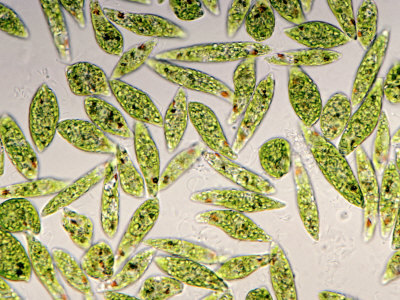 | back 14 Example of Clade Excavata (Euglena) |
front 15 Characteristics of Euglena | back 15 Found in fresh but polluted waters |
front 16  | back 16 Example of Clade Excavata (Trypanosoma) |
front 17 What causes African Sleeping Sickness? | back 17 Trypamosoma |
front 18 Vector for African Sleeping Sickness | back 18 Tsetse fly |
front 19 Why is African Sleeping sickness difficult to treat? | back 19 Surface is covered with multiple copies of a single protein, before the immune system can attack, surface protein switches. |
front 20  | back 20 Example of Clade Chromalveolata: Dinoflagellate called (Ceratium) |
front 21  | back 21 Example of Clade Chromalveolata (Plasmodium) - causes Malaria |
front 22 What causes Malaria? | back 22 Plasmodium |
front 23  | back 23 Example of Clade Chromalveolata (Paramecium caudatum) (slipper shaped) (ciliate) |
front 24  | back 24 Example of Clade Chromalveolata (Diatoms) |
front 25 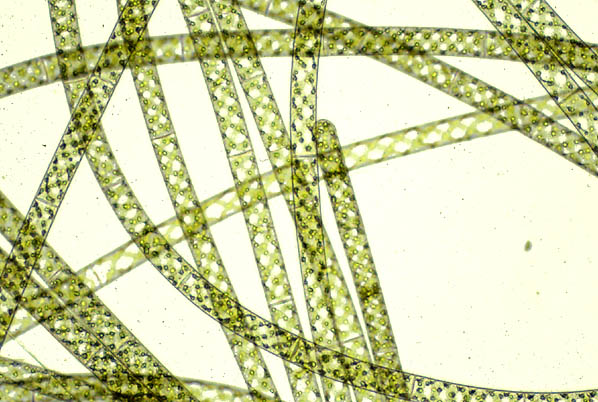 | back 25 Example of Clade Archaeplastida (Green algae) (Spirogyra) |
front 26 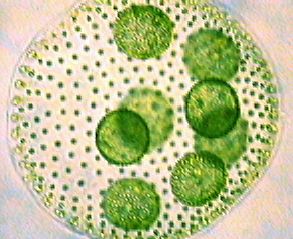 | back 26 Example of Clade Archaeplastida (green algae) (Volvox) |
front 27 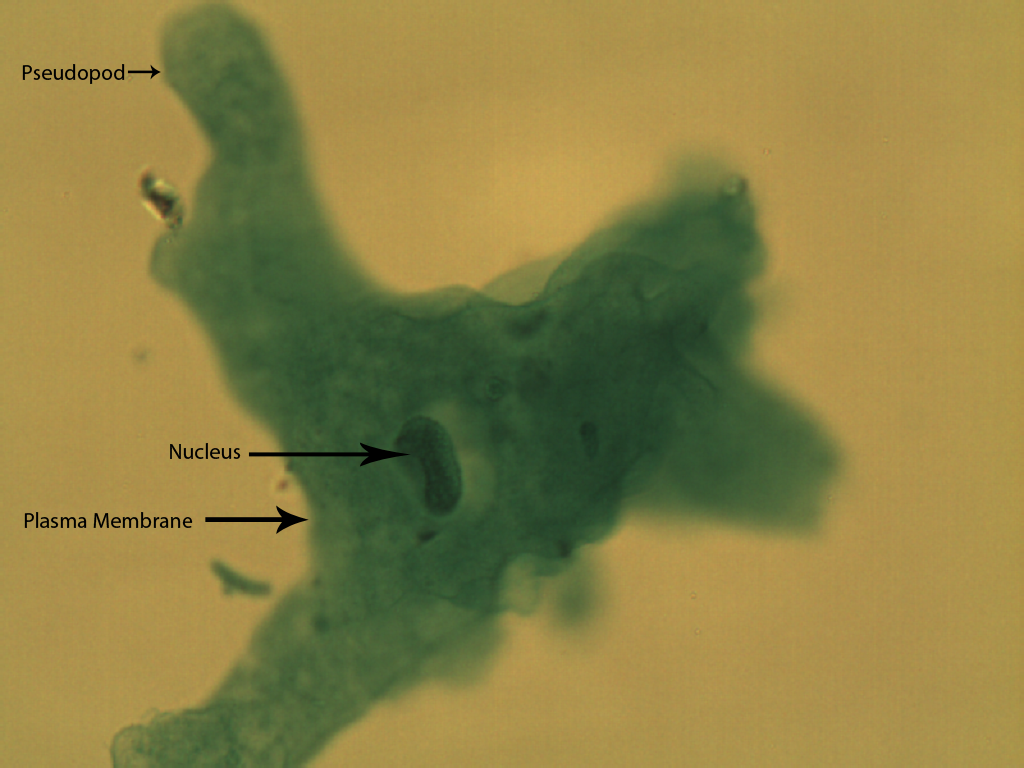 | back 27 Example of Clade Unikonta (Amoeba Proteus) |
front 28 What is the cell wall of diatoms made of? | back 28 Silica |
front 29 What is plankton? | back 29 bottom of the food chain in marine waters |
front 30 What is a distinctive feature seen in Paramecium? | back 30 2 nuclei, macronucleus and micronuclei |
front 31 What is a distinctive feature seen in spirogyra? | back 31 Spiral shaped chloroplasts. |
front 32 What kind of algae is Volvox? | back 32 Green algae. |
front 33 How does the amoeba move? | back 33 pseudopods |
front 34 Name the process by which amoeba ingests its food? | back 34 Phagocytosis |
front 35 Why would you expect a fresh water amoeba to be more likely to have a contractile vacuole than a marine amoeba? | back 35 A freshwater amoeba lives in a hypotonic environment, water enters by osmosis. Contractile vacuole needed to pump out excess water.
|
front 36 Exercise 11 | back 36 Kingdom Animalia: Sponges and Cnidarians |
front 37 The Animal Kingdom is characterized by: | back 37 multicellular, eukaryotic organisms that obtain their nutrients by feeding on other animals, plants or fungi. |
front 38 Characteristics of Animal Kingdom: | back 38 heterotrophic, multicellular organisms |
front 39 What animal does not have tissues, organs or organ systems? | back 39 Sponges |
front 40 Characteristics of Sponges: | back 40 Heterotrophic, filter feeders, asexual reproduction (budding), no tissues, neither protostomes or deuterostomes, sessile, hermaphrodites |
front 41 What Phylum do sponges belong to? | back 41 Porifera (porous body) |
front 42 What are the classes of sponges? | back 42 Calcarea, Hexactinellida, Demospongiae |
front 43  | back 43 Class Calcarea (sponge) |
front 44  | back 44 Class Hezactinellida (sponge) |
front 45  | back 45 Class Demospongiae (sponge) |
front 46 Why are sponges so different from other animals in the Kingdom Animalia? | back 46 No tissues, organ systems, coelom, or organs. |
front 47 Phylum Cnidarian | back 47 Have true tissues but no organs or organ systems. Radial symmetry. Aquatic. |
front 48 Characteristics of Phylum Cnidarian: | back 48 Radial symmetry, aquatic, three body forms. |
front 49 The two tissue layers in Phylum Cnidarian? | back 49 Epidermis, and inner gastrodermis. |
front 50 Coelenteron: | back 50 The gastrovascular cavity in Phylum Cnidarian. |
front 51 Cnidocyte: | back 51 Cell type in cnidarians, "stinging cell", helps them capture prey. |
front 52 Two adult forms of Cnidaria? | back 52 Polyp and medusa. |
front 53 hydroid or polyp form: | back 53 colonial, not free-moving. |
front 54 Medusa form: | back 54 Free moving, |
front 55 Are jellyfish medusa or colonial? | back 55 Medusa |
front 56 3 Classes of phylum Cnidaria: | back 56 Hydrozoa, Scyphozoa, and Anthozoa. |
front 57 Examples of Class Hydrozoa: | back 57 Hydra, Obelia, and Portugese man of war. |
front 58  | back 58 Polyp form of Obelia. (Class Hydrozoa) |
front 59 | back 59 Medusa form of Obelia. (Class Hydrozoa) |
front 60 Is the Portugese man-of war medusa or colonies of individual polyps? | back 60 Floating colonies of individual polyps. |
front 61 Examples of Class Scyphozoa: | back 61 Jellyfish (Class Scyphozoa) (always medusa) |
front 62 Examples of Class Anthozoa: | back 62 Corals and sea anemones. |
front 63 Characteristics of Class Anthozoa: | back 63 Display the polyp form and live in colonies. |
front 64 Which genus in Phylum Cnidaria displays both polyp and medusa adult forms? | back 64 Obelia. |
front 65 What is the name of the class in which jellyfish belong? | back 65 Class Scyphozoa. |
front 66 What is the name of the class to which coral belong? | back 66 Class Anthozoa. |
front 67 Which class of cnidarians always shows the medusa form? | back 67 Class Scyphozoa, jellyfish. |
front 68 Are Cnidarians protostomes or deuterostomes? | back 68 Neither. |
front 69 Exercise 12 | back 69 Kingdom Animalia Protostomes: Phyla Platyhelminthes, Nematoda, annelida, Mollusca and Arthropoda. |
front 70 Protostome: | back 70 A developmental term that describes the first opening as the forerunner to the animal's mouth. The mouth develops first. |
front 71 Phylum of Kingdom Animalia Protostomes: | back 71 Platyhelminthes, Nematoda, Annelida, Mollusca, Arthropoda. |
front 72 What phylum are "flat worms" in? | back 72 Phylum Platyhelminthes. |
front 73 Round worms that are unsegmented belong to what Phylum? | back 73 Phylum Nematoda. |
front 74 Segmented round worms belong to what phylum? | back 74 Phylum Annelida. |
front 75 What phylum do mollusks belong to? | back 75 Phylum Mollusca. |
front 76 What phylum to insects and crustaceans belong to? | back 76 Phylum Arthropoda. |
front 77 In what direction are flatworms, flat? | back 77 Dorsal-ventral. |
front 78 Meaning of "Platyhelminthes": | back 78 "Platy":flat and "Helminth":worm |
front 79 Describe the reproductive system of Phylum Platyhelminthes: | back 79 Hermaphrodites. |
front 80 What type of worm is known for being a parasite? | back 80 Flat worms. |
front 81 3 classes of Phylum Platyhelminthes: | back 81 Turbelaria, Trematoda, Cestoda. |
front 82  Example of Class Turbelaria: | back 82 Planaria. |
front 83 Example of Class Trematoda: | back 83 Clonorchis sinesis. (Chinese liver fluke) |
front 84 How to identify the Chinese liver fluke? | back 84 oral sucker |
front 85 The three hosts of the Chinese Liver fluke: | back 85 Human, snail, and fish. |
front 86 Life-cycle of a chinese liver fluke? | back 86 1. Human eats raw or undercooked fish, that contains immature flukes.
|
front 87 Example of Class Cestoda: | back 87 Tapeworms. |
front 88 Scientific name for tapeworm? | back 88 Dipylidium caninum. |
front 89 Proglottids: | back 89 Repeating units in a tapeworm. |
front 90 Scolex | back 90 Head of a tapeworm |
front 91 Can a tapeworm regenerate? | back 91 Yes because of its proglottids. |
front 92 Lifecycle of a tapeworm: | back 92 1. Human eats undercooked pork that contains tapeworm cysts. 2. Cysts attatch to intestinal wall. 3. Eggs from tapeworm pass in feces. 4. Pig eats infected food. 5. Pig's muscles are filled with larvae cysts. |
front 93 What part of a tapeworm attaches to a dog's intestinal wall? | back 93 Scolex. |
front 94 Classes in Phylum Nematoda: | back 94 Polychaeta, Hirudinea, and Oligochaeta. |
front 95 Phylum Nematoda consists of: | back 95 Round, unsegmented worms with bilateral symmetry. |
front 96 How do you tell male from female worm? | back 96 Female is bigger and male has a hook at the end. |
front 97  | back 97 Ascaris (Nematoda) |
front 98  | back 98 Trichinella spiralis (nematoda) |
front 99 How do you get Trichinella spiralis? | back 99 Eat under cooked pork. |
front 100 Phylum Annelida consists of: | back 100 Round, segmented worms with bilateral symmetry. |
front 101 What worm phylum has a true coelom? | back 101 Phylum Annelida |
front 102 Classes in Phylum Annelida: | back 102 Polychaeta, Hirudinea, Oligochaeta. |
front 103 Look at Earthworm dissection picture and website: | back 103 http://www.mhhe.com/biosci/genbio/virtual_labs/BL_14/BL_14.html |
front 104 Examples of Class Polychaeta: | back 104 Sandworms, and marine worms. |
front 105 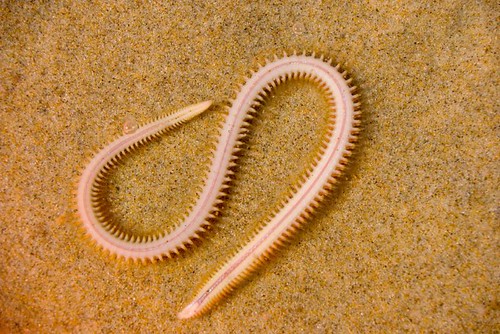 | back 105 Sand worm |
front 106 Example of Class Hirudinea: | back 106 Leeches |
front 107 Example of Class Oligochaeta: | back 107 Earthworm |
front 108 What Class do earthworms belong to? | back 108 Oligochaeta |
front 109 Phylum Mollusca: | back 109 Soft bodied animals, many with outer shells and a bilaterally symmetrical body plan with three areas called foot, mantle, and visceral mass. Animals live in land or water. |
front 110 5 classes of Phylum MolluscaL: | back 110 Polyplacophora, Bivalvia, Gastropoda, Cephalopoda, Scaphopoda, and Arthropoda. |
front 111 Class Polyplacophora: | back 111 Chitons, lives in intertidal regions. (sea rollie-pollie) |
front 112 Class Bivalvia: | back 112 Clams, oysters, mussels, and scallops. Two shells connected together at a hinge joint. |
front 113 Class Gastropoda: | back 113 Snails, slugs, welks and conchs. |
front 114 Class Cephalopoda: | back 114 Squid, octopus, and the nautilus shell. |
front 115 Siphon (squid): | back 115 Helps the squid propel itself backwards |
front 116  | back 116 Tusk shells. (Class Scaphopoda) |
front 117 Class Scaphopoda: | back 117 Tusk shells |
front 118 Phylum Arthropoda: | back 118 Insects and crustaceans. |
front 119 What are exoskeletons made of? | back 119 Chitin. |
front 120 Go back and write characteristics of each phylum and class. | back 120 no data |
front 121 The 3 body regions of Arthropoda: | back 121 Head, Thorax, and abdomen. |
front 122 Cephalothorax: | back 122 When the head and thorax are fused together. |
front 123 The 3 subphylum of Phyla Arthropoda: | back 123 Chelicerata, Crustacea and Uniramia |
front 124 Two classes in Sub-Phylum Chelicerata: | back 124 Merostomata (horseshoecrab), and Arachnida (spiders). |
front 125 Class Merostomata: | back 125 Horseshoecrab |
front 126 The horseshoecrab belongs to which Class? | back 126 Merostomata |
front 127 Class Arachnida: | back 127 Spiders |
front 128 Sub-phylum Crustacea: | back 128 Barnacles, and all crustaceans |
front 129 Carapace: | back 129 Outer covering on custacean. |
front 130 Telson: | back 130 Tail on a horseshoecrab |
front 131 3 classes in sub-phylum Uniramia: | back 131 Insecta, Chilopoda, and Diplopoda. |
front 132 Class insecta: | back 132 Insects |
front 133 Class Chilopoda: | back 133 Centepedes |
front 134 Class Diplopoda: | back 134 Millipedes. |
front 135 Earth Worm dissection: | back 135 no data |
front 136 EWD: Clitellum: | back 136 Un-segmented, smooth section, 1/3 down the worm. Where eggs are shed, functions as a cocoon. |
front 137 EWD: Prostomium | back 137 Mouth and overhanging "lip" on an Earth worm. |
front 138 EWD:Setae | back 138 Tony bristles that cover an earth worm. |
front 139 EWD: Septum, or septa | back 139 Segmented section of earth worm body. |
front 140 EWD:The gastrointestinal tract is referred to as the... | back 140 Alimentary canal |
front 141 EWD:What are earth worm "hearts"? | back 141 five enlarged arteries that contract and relax |
front 142 EWD: What are the two major blood vessels? | back 142 Dorsal and ventral |
front 143 Squid dissection: | back 143 no data |
front 144 SD: Mantle: | back 144 the outer covering of the body of the squid |
front 145 Phylum Arthropoda: | back 145 no data |